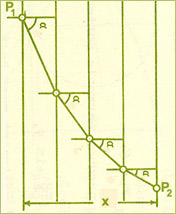Back to . . .  Brachistochrone
Part I Brachistochrone
Part I Brachistochrone
Part II Brachistochrone
Part II |
 The Brachistochrone The Famous Problem of Fastest Descent |
 Deposit #77 |
|
 What is the path
- curve - producing the shortest possible
time for a particle to
descend from a given point to another point not
directly below the start? Will it be a
straight line, an arc of a
circle, or just what? Will it be a minimum of a function?
The shortest distance between two points is
a line, but the descent of a weighted particle is acted upon, in the
very least, by gravity. A bead descending a wire is often
used to depict the pathway, but investigators usually ignore
friction. What is the path
- curve - producing the shortest possible
time for a particle to
descend from a given point to another point not
directly below the start? Will it be a
straight line, an arc of a
circle, or just what? Will it be a minimum of a function?
The shortest distance between two points is
a line, but the descent of a weighted particle is acted upon, in the
very least, by gravity. A bead descending a wire is often
used to depict the pathway, but investigators usually ignore
friction.The correct answer
is that a body takes less time to fall along the arc of a circumference
than to fall along the "line" of a corresponding chord.
The cycloid path allows the particle to move rapidly at first, while in steep descent, and thus build up sufficient speed to overcome the greater distance the particle must travel. Thus, the speed of the descending particle is accelerated by gravity. We introduce a MATHEMATICA® animation. |
 Brachistochrone values are plotted on the x-axis. vs. Linear values appear on the y-axis. The brachistochrone is an inverted cycloid. |
Our
animation features . . .
two
particles "racing," You also need
to be familiar with the cycloid. A cycloid is
the locus of a point on the circumference of a circle rotating along a
fixed line . . . .
|
||
|
A lengthy discussion of the equations is found on two other pages. Brachistochrone
Part II A reproduction of the original Acta figures (1697) is found on Brachistochrone
Part III |
|
Suggestions
for additional code are on the other brachistochrone links.
Note: Spaces have been added
to the text of this code to make it easier to read.
MATHEMATICA® does not permit spaces. |
||
|
The brachistochrone and cycloid have a very rich math and physics literature. The National Curve Bank also has MAPLE animations of the cycloid family of curves. |
||
| Beckmann, Petr, A History of π (PI), St.
Martin's Press, 1971, pp. 139-140. |
||
| Burton, David M., The History of Mathematics, 5th
ed., McGraw Hill, 2003, p. 446. The
brachistochrone is for "the shrewdest
mathematicians of all the world."
John
Bernoulli, June, 1696
|
||
| Eves, Howard, AN
INTRODUCTION TO THE HISTORY OF MATHEMATICS, 6th ed.,
Saunders College Publishing, 1992, p. 426. Leibniz:
"Splendid problem."
|
||
Johnson, Nils P., The
Brachistochrone Problem, The College
Mathematics Journal, vol. 35 (3), May 2004, pp.
192-197.
|
||
| Lockwood, E. H., A Book of CURVES, Cambridge
University Press, 1961, p. 88. |
||
| Katz, Victor J., A
History of Mathematics, 2nd ed., Addison Wesley Longman, 1998,
pp. 547-549, 562. Katz, Victor J., A History of Mathematics, Brief ed., Pearson Addison Wesley, 2004, pp. 250, 331-332. |
||
Simmons, George F., Calculus Gems: Brief Lives and Memorable
Mathematics, McGraw-Hill,1992, pp. 308-313.
|
||
| Szapiro, Ben, Revisiting A Classic Least Time Problem, < http://www.sewanee.edu/physics/TAAPT/TAAPTTALK.html > |
||
Stewart, James, Calculus, 5th ed.,
THOMSONBrooks/Cole,
2003, p. 691.
|
||
| Wagon, Stan, MATHEMATICA®IN
ACTION, W. H. Freeman and Co., 1991, pp. 60-66 and 385-389.
ISBN
0-7167-2229-1 or ISBN 0-7167-2202-X
(pbk.) Wagon, Stan, MATHEMATICA® IN ACTION, 2nd ed., Springer-Verlag, 2000. ISBN 0-387-98684-7 for other animations. |
||
Weisstein, Eric W., CRC Concise Encyclopedia of MATHEMATICS,
CRC Press, 1999.
|
||
| Yates, Robert C., Curves and Their Properties,
NCTM, 1952, pp. 68-69. |


 .
. 





